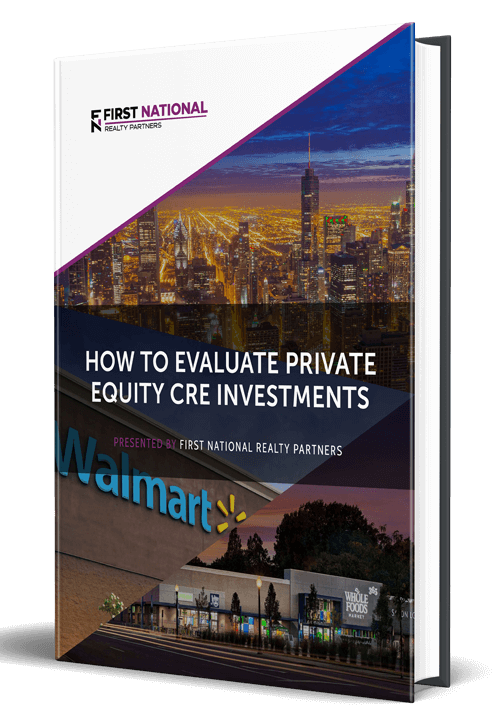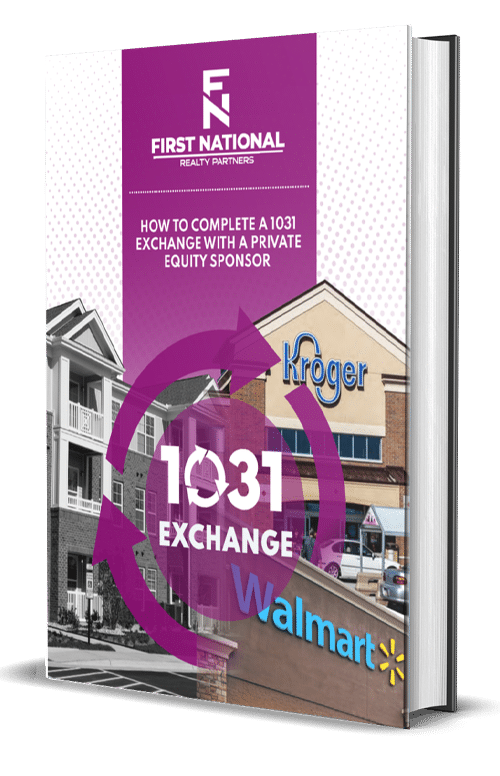For two reasons, commercial real estate assets are rarely purchased with cash. First, they are incredibly expensive, which means they are likely out of reach for all but the most well funded investors. Second, adding a loan to a transaction can help boost returns. So, for this reason, commercial properties are usually purchased with funding from two sources, debt and equity.
In this article, we are going to define debt and equity as it pertains to real estate investing, identify their contribution to a typical commercial property deal, and highlight the key differences between the two. By the end, investors will have a more thorough understanding of the sources of financing that go into a deal to purchase a commercial property.
At First National Realty Partners, we are a private equity firm who specializes in the purchase and management of grocery store anchored retail centers. If you are an accredited investor, interested in partnering with a private equity firm to allocate capital to a commercial real estate investment, click here.
What is The Capital Stack
The term “Capital Stack” (or capital structure) is often used as a shorthand way to refer to the sources of capital used to finance a commercial real estate transaction. At a high level, there are two components, debt and equity, and it is critically important for investors to understand the major differences between the two.
Debt
The easiest way to think about debt is as a loan provided by a bank or real estate lender and there are two types, senior and mezzanine.
Senior debt is by far the most common and usually makes up 50% – 80% of the purchase price depending on a number of factors including property type, location, tenants, and borrowers. It is known as “senior” debt because the lender who provides it receives a “senior” lien on the property that puts first in line for repayment in the event of a bankruptcy or liquidation. This is the “safest” portion of the capital stack so it has the lowest potential return, usually somewhere in the 4% – 8% range for lenders, and it is repaid over time in installments.
Mezzanine debt, sometimes called mezzanine financing, is another type of debt that is “subordinate” to senior debt, but the key difference is that it is not secured by a lien on the property. Instead, it is secured by shares in the LLC used to purchase the property. It is called “mezzanine” debt because it is meant to fill the gap between the amount of senior debt a lender is willing to provide and the amount of equity capital a real estate investor is able to raise. For example, if an investor wanted to purchase a property for $1,000,000 and got approved for $600,000 in senior debt while raising $300,000 in equity, they may seek mezzanine debt of $100,000 to obtain the remainder of the necessary financing. For investors, mezzanine debt is expensive both in terms of the fees charged by the lender and the interest rate paid. For this reason, it is typically only used on an as needed basis. For lenders, mezzanine debt is riskier because they are second in line to be repaid and do not have a claim to the underlying property, which is why they charge higher fees and rates.
Equity
The easiest way to think about real estate equity is as the capital contributed by investors with the hope of achieving a positive return. Like debt, there are two types of equity – preferred and common.
Preferred equity is the most senior type of equity and investors like this position in the capital stack because they are often paid a “preferred return” which means that they are first in line for any money left over after debt payments have been made. Preferred equity holders are also secured by shares of stock in the LLC that owns the property. In terms of risk, preferred equity is more risky than debt, but less risky than common equity.
Finally, the last portion of the capital stack is common equity. Investors in common equity are secured by shares in the LLC that owns the property, but they are last in line to be paid. As such, this is considered the riskiest tranche of the capital stack, but it can also potentially deliver the highest return.
Capital Stack Example
To illustrate how the capital stack works, consider an example where an investor wants to purchase a multifamily apartment building for $1,000,000.
Their likely first step is to work with a bank or lender to arrange the senior debt. Because multifamily is generally considered to be a safer property type, they may be willing to lend 75% of the purchase price or $750,000, which means that the investor needs to raise $250,000 in equity to get to the purchase price.
For the needed equity, investors may use their own money if they have enough. More often than not, they will lead a “syndicate” of investors who will each contribute a portion of the total needed. In this case, say that there are five investors, each of whom contribute $50,000.
With the $750,000 in debt and $250,000 in equity the investor has obtained the financing needed to purchase the property.
Key Differences Between Debt and Equity
Although the general differences between debt and equity are described above, specific, important differences are described in this section – there are eight.
1. Risk Level
From a risk perspective, debt is generally considered to be less risky because it has a higher repayment priority, is secured by an interest in the collateral property, and has the ability to initiate foreclosure proceedings in the event of nonpayment. Debt investors may include banks, hedge funds, life insurance companies, government entities, or specialized CRE lenders. Because debt is less risky, it also delivers a lower return, usually somewhere in the 4% – 8% range.
Equity is riskier because it has a lower repayment priority, does not have an interest in the property, and does not have the ability to initiate foreclosure. For this reason, equity investors demand a higher return that is typically 10% or higher. Equity investors usually include high net worth individuals, partnerships, and even corporations.
2. Taxation
From an investor’s perspective, there is a significant difference between the tax treatment of debt and equity.
Debt investors receive periodic payments of principal and interest on the money lent, which means that they have little chance to achieve a gain on their investment. As a result, their primary tax is on the income received, which is typically taxed as ordinary income.
Equity investors may receive regular dividends, which are taxed as ordinary income. But, if a property is sold for a gain, they may also experience a “capital gain” which is subject to capital gains tax depending on how long the investment was held. In addition, equity holders have the chance to defer capital gains taxes on their equity position, something not available to debt holders.
3. Ownership
Nearly all commercial properties are purchased with a Limited Liability Corporation (LLC), which are companies formed just for the purpose of buying the property.
Debt holders do not have an ownership interest in the LLC. Instead, they are secured by a lien against the property which is released when the debt is repaid in full.
Equity holders do take an ownership interest in the LLC in proportion to the amount invested. As such, they stand to benefit greatly when a property’s value appreciates
4. Entry Costs
For most investments, there is a minimum amount that investors must commit to participate. In both cases, the minimum amount is set by the deal leader, but is often in the range of $25,000 – $50,000 or more.
Perhaps more important than the minimum investment is that all investors in privately run transactions must have the financial resources to qualify as an “Accredited Investor.” Under SEC rules, an Accredited Investor is one who has a minimum of $1MM in net worth or has earned income of at least $200,000 in each of the past two years.
5. Operation Costs
There are certain operational costs that are incurred in the operation of a commercial property. For example, property taxes, insurance, maintenance, utilities, and legal expenses are typical of commercial property operations. When these expenses are deducted from rental revenue, the result is a metric known as “Net Operating Income” or NOI for short.
Because debt holders are first in line to be repaid, they will be paid from whatever funds are available in Net Operating Income. Then, once debt holders are paid, any remaining funds go to equity holders in proportion to the number of shares owned. For example, suppose a property produces $100,000 in net operating income and the required debt service is $80,000. Debt holders are paid their $80,000 first and the remaining $20,000 goes to equity holders.
So, another way to think about the expense hierarchy here is that the property’s rental income produces one big pot of money. From that, operating costs are first subtracted, the debt service, and anything left over goes to equity holders.
6. Returns
Remember the fundamental concept in any type of investment, there is a direct correlation between risk and return. The lower the risk, the lower the return and, conversely, the higher the risk the higher the potential return.
Because debt holders are first in line to be repaid, have a senior lien on the property, and have the ability to initiate foreclosure proceedings, they are in a lower risk position – which means they typically earn a lower return. As a general rule, debt holders can expect a return in the range of 4% – 8% annually with a high degree of stability and no upside from property appreciation.
Because debt holders are in a subordinate position, do not have a claim to the property, and do not have the ability to initiate foreclosure, they are in a riskier position. But, they stand to benefit from property appreciation which means that their potential returns can be significant if the property is successful. As a general rule, equity holders can expect a rate of return of 10%+ annually with high variability based on the success of the investment.
7. Appreciation
In an ideal scenario, a property is purchased for some amount of money, held for a period of time over which the value appreciates, and then sold for a profit at the end of the holding period.
As described in the section above, debt holders do not benefit from price appreciation. Instead, their debt financing is repaid in full with interest. On the other hand, equity holders do benefit from price appreciation, sometimes in a big way. To illustrate this point, the example above is continued.
Remember, in the example, an investor purchased a property for $1,000,000 and used $750,000 in debt and $250,000 in equity financing to do so. Now suppose that, over a five year holding period, the regular loan payments reduced the balance to $650,000 while market conditions propelled the value of the property to $1,250,000, the price for which it is sold. In this scenario, here is how the sales price is divided up. First, the loan balance is paid, which satisfies the debt holders interest, leaving $600,000 left over for equity holders who benefit significantly from the appreciation, ultimately earning 2.4x their initial investment.
While this example may make the equity position seem very attractive, it is important to note that it can also go the other way. If the property declined in value and was sold for $600,000, all the money would go to debt holders and there would be nothing left over for equity holders. It is important to keep this in mind when underwriting the cash flow of the deal.
8. Duration
The “duration” of the investment is the amount of time that it must be held until it can be liquidated. For both debt and equity, the expected duration is the same as the investment’s planned holding period, usually 5-10 years.
However, there may be an exception for occasions where debt is “refinanced” to take advantage or more favorable terms. In such cases, the original debt is retired and equity holders may get a distribution equal to some or all of their initial investment.
The broader point is that the duration of the investment varies widely from one deal to another based on the type of real estate, market conditions, and the general investment strategy.
Why to Invest in Debt
While every investor’s needs are unique, debt tends to be a good fit for those who prefer stability, certainty, regular income (from the loan payments) and preservation of capital. In short, investors should consider debt when they want a lower, but stable and steady return.
Why to Invest in Equity
Equity investment opportunities tend to be a good fit for investors who are willing to take a bit more risk in pursuit of a higher return. Usually, these are younger investors who have the benefit of time on their side to let their equity grow.
Summary of Debt vs. Equity in Commercial Real Estate
In commercial real estate, the term “capital stack” is commonly used to refer to the collection of capital used to finance a property purchase. At a high level, there are two components, debt and equity.
Real Estate Debt is money that is provided by a bank or real estate lender and it is secured by a lien on the property. In return for their capital, debt holders get regular payments of principal and interest and the ability to foreclose on the property if needed. Debt is safer than equity, but also offers a lower potential return with little to no participation in a profitable sale.
Equity is the money that makes up the difference between a property’s purchase price and the amount of debt. Equity is typically provided by investors who want to participate in the income and profits produced by the underlying property. Equity is riskier than debt, but can also potentially offer higher returns.
Debt tends to be a good fit for investors who value stability, safety, and preservation of capital while equity tends to be a good fit for those willing to take higher risk in pursuit of higher, more variable returns.
For individuals considering an investment in a commercial real estate property, it is important to understand the differences between debt and equity and to invest in the option with which they are most comfortable.
Interested In Learning More?
First National Realty Partners is one of the country’s leading private equity commercial real estate investment firms. With an intentional focus on finding world-class, multi-tenanted assets well below intrinsic value, we seek to create superior long-term, risk-adjusted returns for our investors while creating strong economic assets for the communities we invest in.
If you would like to learn more about our commercial real estate investment opportunities, contact us at (800) 605-4966 or info@fnrpusa.com for more information.






